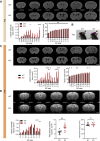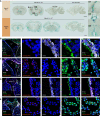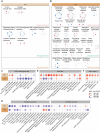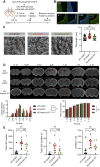Loss of Katnal2 leads to ependymal ciliary hyperfunction and autism-related phenotypes in mice
- PMID: 38718086
- PMCID: PMC11104772
- DOI: 10.1371/journal.pbio.3002596
Loss of Katnal2 leads to ependymal ciliary hyperfunction and autism-related phenotypes in mice
Abstract
Autism spectrum disorders (ASD) frequently accompany macrocephaly, which often involves hydrocephalic enlargement of brain ventricles. Katnal2 is a microtubule-regulatory protein strongly linked to ASD, but it remains unclear whether Katnal2 knockout (KO) in mice leads to microtubule- and ASD-related molecular, synaptic, brain, and behavioral phenotypes. We found that Katnal2-KO mice display ASD-like social communication deficits and age-dependent progressive ventricular enlargements. The latter involves increased length and beating frequency of motile cilia on ependymal cells lining ventricles. Katnal2-KO hippocampal neurons surrounded by enlarged lateral ventricles show progressive synaptic deficits that correlate with ASD-like transcriptomic changes involving synaptic gene down-regulation. Importantly, early postnatal Katnal2 re-expression prevents ciliary, ventricular, and behavioral phenotypes in Katnal2-KO adults, suggesting a causal relationship and a potential treatment. Therefore, Katnal2 negatively regulates ependymal ciliary function and its deletion in mice leads to ependymal ciliary hyperfunction and hydrocephalus accompanying ASD-related behavioral, synaptic, and transcriptomic changes.
Copyright: © 2024 Kang et al. This is an open access article distributed under the terms of the Creative Commons Attribution License, which permits unrestricted use, distribution, and reproduction in any medium, provided the original author and source are credited.
Conflict of interest statement
The authors have declared that no competing interests exist.
Figures






References
-
- Shen MD, Nordahl CW, Li DD, Lee A, Angkustsiri K, Emerson RW, et al.. Extra-axial cerebrospinal fluid in high-risk and normal-risk children with autism aged 2–4 years: a case-control study. Lancet Psychiatry. 2018;5(11):895–904. Epub 20180927. doi: 10.1016/S2215-0366(18)30294-3 ; PubMed Central PMCID: PMC6223655. - DOI - PMC - PubMed
MeSH terms
Substances
LinkOut - more resources
Full Text Sources
Medical
Molecular Biology Databases
Research Materials

